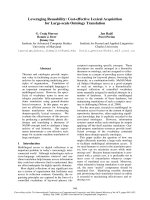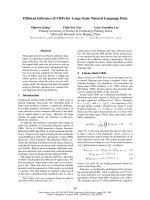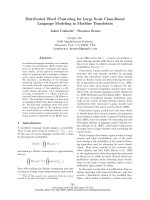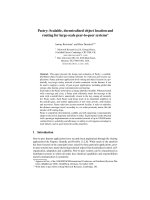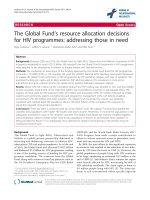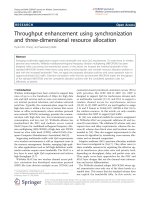Multi dimensional resource allocation strategy for large scale computational grid systems
Bạn đang xem bản rút gọn của tài liệu. Xem và tải ngay bản đầy đủ của tài liệu tại đây (1.79 MB, 76 trang )
Multi-Dimensional Resource Allocation Strategy
for Large-Scale Computational Grid Systems
Benjamin Khoo Boon Tat
(B. Eng (Hons), NUS)
A THESIS SUBMITTED
FOR THE DEGREE OF MASTER OF ENGINEERING
DEPARTMENT OF ELECTRICAL AND COMPUTER ENGINEERING
NATIONAL UNIVERSITY OF SINGAPORE
2006
1
Abstract
In this thesis, we propose a novel distributed resource-scheduling algorithm
capable of handling multiple resource requirements for jobs that arrive in a
Grid Computing Environment. In our proposed algorithm, referred to as MultiDimension Resource Scheduling (MRS) algorithm, we take into account both
the site capabilities and the resource requirements of jobs. The main objective
of the algorithm is to obtain a minimal execution schedule through efficient
management of available Grid resources. We first propose a model in which the
job and site resource characteristics can be captured together and used in the
scheduling algorithm. To do so, we introduce the concept of a n-dimensional
virtual map and resource potential. Based on the proposed model, we conduct
rigorous simulation experiments with real-life workload traces reported in the
literature to quantify the performance. We compare our strategy with most
of the commonly used algorithms in place on performance metrics such as,
job wait times, queue completion times, and average resource utilization. Our
combined consideration of job and resource characteristics is shown to render
high-performance with respect to above-mentioned metrics in the environment.
Our study also reveals the fact that MRS scheme has a capability to adapt
to both serial and parallel job requirements, especially when job fragmentation
occurs. Our experimental results clearly show that MRS outperforms other
strategies and we highlight the impact and importance of our strategy.
We further investigate the capability of this algorithm to handle failures
through dimension expansion. Three types of pro-active failure handling strategies for grid environments are proposed. These strategies estimates the availability of resources in the Grid, and also preemptively calculate the expected long
term capacity of the Grid. Using these strategies, we create modified versions
of the backfill and replication algorithms to include all three pro- active strategies to ascertain each of its effectiveness in the prevention of job failures during
execution. A variation of MRS called 3D-MRS is presented. The extended algo-
2
rithm continues shows continual improvement when operating under the same
execution environment. In our experiments, we compare these enhanced algorithms to their original forms, and show that pro-active failure handling is able
to, in some cases, achieve a 0% job failure rate during execution. Also, we show
that a combination of node based prediction and site capacity filter used with
MRS provides the best balance of enhanced throughput and job failures during
execution in the algorithms we have considered.
Keywords: Grid computing, scheduling, parallel processing time, multiple resources, load distribution, failure, fault tolerance, dynamic grids, failure handling
3
Acknowledgments
I would like to express gratitude for my supervisor Bharadwaj Veeravalli for
his guidance, advice and support throughout the course of this work. The
assistance and lively discussions with him has provided much of the motivation
and inspiration during the course of research. This thesis would not have been
possible without his guidance, ideas and contributions.
I would also like to express my appreciation for my ex-colleagues from International Business Machines (IBM), IBM e-Technology Center (e-TC) and the
Institute of High Performance Computing (IHPC). Without the opportunities
from IBM and working with e-TC (John Adams and team), the ideas rooted
for this thesis would never have materialized. The involvement in commercial
Grid Computing projects with IBM also proved to be a great background to
the understanding of real problems faced in the commercial sector. Also a big
thank-you to Chia Weng Wai (IBM) for taking the time to explain the perspective of failure in the eyes of the commercial customers.
Many thanks also goes to good friend and colleague, Ganesan Subramanium
(IHPC), for our many tea-breaks to discuss ideas that could be used in this
research. While some of them might not have worked out, the ideas they represented certainly worked towards to goal of this research. Thanks also goes to
Terence Hung (IHPC) for being an understanding manager, and allowing me to
combine my work responsibilities and research interest during my stay in IHPC.
His guidance and candid comments has also helped refine this work.
Special thanks also goes to Simon See Chong Wee (SUN Micro-systems) for
encouraging me to put my initial ideas unto paper which became the basis of
this thesis. His initial guidance and perspective in this work was encouraging
and invaluable to its outcome.
What i have done during the pursuit of this degree would not have been
possible without the support of my family, Veronica Lim. I cannot begin to
express the gratitude for her on the sacrifices she made in order for me to
4
pursue this degree and finally put my ideas unto paper.
I would also like to acknowledge National University of Singapore for giving
me the opportunity to pursue this degree with my ideas. Last but not least, i
would like to thank anyone i have failed to mention that have made this work
possible.
5
Contents
1 Introduction
10
1.1
Related Works . . . . . . . . . . . . . . . . . . . . . . . . . . . .
11
1.2
Our Contributions . . . . . . . . . . . . . . . . . . . . . . . . . .
16
1.3
Organization of Thesis . . . . . . . . . . . . . . . . . . . . . . . .
17
2 Grid Computing Model
19
2.1
Resource Environment for Grid Computing . . . . . . . . . . . .
19
2.2
Failure Model for Grid Computing . . . . . . . . . . . . . . . . .
21
2.3
Performance measures . . . . . . . . . . . . . . . . . . . . . . . .
25
3 Allocation strategy and Algorithms
3.1
3.2
3.3
28
Multi-dimension scheduling . . . . . . . . . . . . . . . . . . . . .
28
3.1.1
Computation Dimension . . . . . . . . . . . . . . . . . . .
29
3.1.2
Computational Index through Aggregation . . . . . . . .
31
3.1.3
Data Dimension and indexing through resource inter-relation 32
3.1.4
Dimension Merging . . . . . . . . . . . . . . . . . . . . . .
33
Formulation for Failure Prediction . . . . . . . . . . . . . . . . .
34
3.2.1
Pro-active Failure Handling versus Passive Failure Handling 35
3.2.2
Mathematical Modeling . . . . . . . . . . . . . . . . . . .
36
3.2.3
Comparing Replication and Prediction . . . . . . . . . . .
41
Improving Resilience of Algorithms . . . . . . . . . . . . . . . . .
46
3.3.1
Pro-active failure handling strategies . . . . . . . . . . . .
46
3.3.2
Modifications to Algorithms . . . . . . . . . . . . . . . . .
47
4 Performance Evaluation
50
4.1
Simulation Design . . . . . . . . . . . . . . . . . . . . . . . . . .
50
4.2
MRS Results, Analysis and Discussions . . . . . . . . . . . . . .
57
4.3
Pro-active Failure Handling Results, Analysis and Discussions . .
61
4.3.1
61
Performance of the unmodified algorithms . . . . . . . . .
6
4.3.2
Performance of the modified algorithms in a DG environment . . . . . . . . . . . . . . . . . . . . . . . . . . . . . .
4.3.3
Performance of the modified algorithms in a EG environment . . . . . . . . . . . . . . . . . . . . . . . . . . . . . .
4.3.4
65
66
Performance of the modified algorithms in a HG environment . . . . . . . . . . . . . . . . . . . . . . . . . . . . . .
67
5 Conclusion
68
6 Future works
70
7
List of Figures
1
Illustration of a physical network layout of a GCE. . . . . . . . .
22
2
Resource view of physical environment with access considerations
22
3
Resource Life Cycle Model for resources in the GCE . . . . . . .
24
4
Flattened network view of resources for computation of Potential
30
5
A Virtual Map is created for each job to determine allocation . .
34
6
Passive and Pro-active mechanisms used to handle failure . . . .
35
7
Probability of success versus α under varying replication factors K 42
8
Probability of success P r versus Er under varying division factors k 44
9
Probability of success P r versus Er under varying R with division
factor k = 4 . . . . . . . . . . . . . . . . . . . . . . . . . . . . . .
45
10
Workload model profile provided by [25] . . . . . . . . . . . . . .
58
11
Normalized comparison of simulation to Backfill Algorithm . . .
58
12
Simulation results for DG under different Run-Factors . . . . . .
62
13
Simulation results for EG under different Run-Factors . . . . . .
63
14
Simulation results for HG under different Run-Factors . . . . . .
64
8
List of Tables
1
Table of Simulated Environments . . . . . . . . . . . . . . . . . .
55
2
Experimental results comparing BACKFILL, REP and MRS . .
57
9
1
Introduction
With recent technological advances in computing, the cost of computing has
greatly decreased, bringing powerful and cheap computing power into the hands
of more individuals in the form of Commodity-Off-The-Shelf (COTS) desktops
and servers. Together with the increasing number of high bandwidth networks
provided at a lowered cost, use of these distributed resources as a powerful computation platform has increased. Vendors such as IBM [1, 2], HP [3] and Sun
Micro-systems [4] have all introduced clusters that would effectively lower the
cost-per-gigaflop of processing while maintaining high performance using locally
distributed systems. The concept of Grid Computing [5] has further pushed the
envelope of distributed computing, moving traditionally local resources such as
memory, disk and CPUs to a wide area distributed computing platform sharing
these very same resources. Consequently, what had used to be optimal in performance for a local cluster has suddenly become a serious problem when high
latency networks, uneven resource distributions, and low node reliability guarantees, are added into the system. Scheduling strategies for these distributed
systems are also affected as more resources and requirements have to be addressed in a Grid system. The lack of centralized control in Grids has also
resulted in failure of traditional scheduling algorithms where different policies
might hinder the sharing of specific resources. This leads to a lack of robust
scheduling algorithms that are available for Grids.
At the same time, as more people become aware of Grids, the types of computational environment has also changed. On one hand, large scale collaborative
Grids continue to grow, allowing both intra and inter organizations to access
vast amount of computing power, on the other, increasing number of individuals
are starting to take part in voluntary computations, involved in projects such
as Seti@Home or Folding@Home. Commercial organizations are also beginning
to take notice of the potential capacities available within their organization if
the workstations are aggregated into their computing resource pool.
10
These increase in awareness, has lead to various products, both in research
and commercial, that handles resource allocation and scheduling of jobs to harness these computation powers. Products such as Platform LSF [34] or the
Sun Grid Engine [35] provides algorithms and strategies that handles Dedicated
Grid Computing Environments (GCE) well, but is unable to work optimally
in Desktop Grid environments due to the high rate of resource failures. The
same applies for technologies such as United Devices [36] or xGrid [37], whereby
although it excels in Desktop Grid (EG) environments, is unable to provide the
same level of performance in Dedicated Grid (DG) environments. This is due
to the assumptions made on the possibly high failure rates, resulting in simple
scheduling algorithms used in such systems.
Given the ability to preemptively know about failures and to handle it adequately would allow the rise of a new class of scheduling algorithms that is able
to prevent job failures resulting from the failure in the execution environment.
Coupling this with the fact that handling job failures can help to reduce the
turn-around time for a successful job completion, it would be then possible to
create large scale scheduling algorithms where it is able to know, estimate and
allocate jobs to resources that can fulfill its task with minimal interruptions
and re-scheduling. Together with a well designed multiple resource scheduling
mechanism, it will ultimately result in higher throughput, and a higher level
of quality for jobs submitted to Grids. This motivates to invent new strategies
that take into account the failure possibilities to render best services.
1.1
Related Works
There have been other strategies introduced to handle resource optimization for
jobs submitted over Grids. However, while some investigated strategies to obtain
optimizations in the computational time domain, others looked at optimizations
in data or I/O domain. Recently, more creative methods to achieve optimal
scheduling have included the concept of the costs of resources in financial terms.
Some of these techniques, which are relevant to the context of this paper, will
11
be introduced below.
In [6], job optimization is handled by redundantly allocating jobs to multiple
sites instead of sending it only to the least loaded site. The rationale in this
scheme was that the fastest queue will allow a job to execute before its replicas
and this provides low wait times and improves turn-around time. Job failures
due sites going offline would also be better handled due to the redundancy in
job allocation. However, this strategy leads to problems where queue lengths
of different sites are unnecessarily loaded to handle the same job. The frequent
changes in queue length can also potentially hamper on-site scheduling algorithms to work effectively as schedules are typically built by looking ahead in
the queue. In addition, the method proposed does not investigate the problems
that can arise when the data required for the job is not available at the execution site and needs to be transported for a successful execution. MRS works to
eliminate these issues by allocating only the right amount of resources to jobs
that require it, thus freeing up queues from potentially non-executing jobs.
In [7], Zhang has highlighted that the execution profiles of many applications
are only known in real-time, which makes it difficult for an “acceptance test”
to be carried out. The study also broke down the various scheduling models
into 1) Centralized, wherein all jobs are submitted at a central location for
scheduling and dispatching, 2) Decentralized, wherein jobs are submitted at
their local locations for dispatching, and 3) Hierarchical model, wherein jobs
are submitted to a meta-scheduler but are dispatched to low-level schedulers
for dispatching and execution. Effective virtualization of resources was also
proposed in order to abstract the resource environment and hide the physical
boundaries defined. A buddy set as in [8] was also proposed, and its effectiveness
also highlighted in [18], where it was shown that when groups of trusted nodes
co-operate, the resulting performance is superior compared to situations where
there is no relationship establishment between nodes. However, in both cases,
the strategies proposed looks plainly at the computational requirements of a
job and does not consider the data resource required. It also does not address
12
resource allocation pertaining to both serial and parallel job requirements. MRS
effectively applies the concept of co-operation and virtualization to exploit the
advantages presented in [18, 8], but includes knowledge of bandwidth to account
for I/O and communication overheads. While this allows us to apply MRS to
both serial and parallel jobs, it also allows us to efficiently schedule in a Grid
environment where the data resources are distributed.
In the work presented in [9], the ability to schedule a job in accordance to
multiple (K) resources is explored. Although the approach was not designed
with the Grid environment in mind, the simulation work presented in [9] shows
clearly the potential benefits where scheduling with multiple resources is concerned. Performance gains of up to 50% were achieved when including effective
resources-awareness in the scheduling algorithm. Similar resource awareness
and multi-objective based optimizations were studied in [21]. In both cases,
the limitations of conventional methods were also identified as there were no
mechanisms for utilizing additional information known about the system and
its environment. However, in [9], there were no data resources identified, while in
[21], we believe that the over simplicity of resource aggregation was in-adequate
in capturing resource relationships. MRS proposes a more complex form of resource aggregation that allows for better expression of resource relationships,
while maintaining simplicity in the algorithm construction. At the same time
we continue to consider multiple resources which include both computational
and data requirements.
In [10] data replication and reuse of resources were looked into as a means of
establishing a Grid being able to handle large data (i.e., Data Grid). Elizeu et.
al. has looked into the classification of tasks that are processors of huge data
(pHD), where by processes require large datasets and data reuse is possible.
They introduced a term referred to as Storage Affinity, which takes into account
how reusable is a set of data by pHDs or a bag of tasks. This also determines
if a task should be sent to a location where the required data resides or vice
versa. Following this, task replication [44] is used to reduce the wait time of
13
the job. This method is useful to handle pre-replicated or re-usable data but
does not address how the data would be best scheduled for applications with
no reusable data. However, [10] has demonstrated that it is possible to improve
response times for jobs through smart data management. We build on this
concept of Affinity in our algorithm, combined with better resource relationship
representation, to arrive at a strategy that would allow the overall overheads of
data transmission to be minimized. This is done with no detrimental effect on
the wait times of a job and the overall queue completion of the Grid environment.
Contributions in [11] considered the idea of replication and further included
a data catalog method to discover and the best location to use. Making use
of the Network Weather Service [12], it is possible to determine the best node
to collect the data from/send a job to. Then, a compute-data pair is assigned
with the earliest completion time. This method has again identified that data
optimization is critical to the response time of a job. This however, does not
exploit resource locality w.r.t the serial or parallel job requirements. This is
thus unsuitable for jobs that are highly parallel in nature (i.e., for applications
customized for distributed memory systems). We look upon parallel jobs as applications that require low latency and high bandwidth, and assign the resource
allocation such that both parallel and serial jobs are optimized.
In [13], Ranaganathan et. al. presented that Computation Scheduling and
Data Scheduling can be considered asynchronously in Data-Intensive Applications. The study considered External Schedulers, local Schedulers and Data
schedulers. It concludes that data movement and computation need not always
be coupled for consideration together. While this might be true, and demonstrated in [11], through High Energy Physics applications, this is not always the
case when MPICH-G2 type applications [14, 17] are concerned. MRS recognizes
parallel job requirements and, by using affinity and combined resource allocation, decides the best sites for the job to be dispatched to such that everything
is in the same path.
Other projects such as the Storage Resource Broker [15] and OGSA-DAI
14
[23] mainly concentrate on assisting the access and integration of data in a
distributed computing environment such as a Grid. By itself, these middle-ware
does not decide nor allocate the availability of data resources.
While many other works such as [19, 20] continue to provide algorithms to
effectively allocate resources, much of these work on the premise of [13] where
data and computation resource requirements are handled separately. While
these mechanisms are shown to be effective in Monte-Carlo or parameter sweep
type applications where the tasks or sub tasks are considered to be independent,
we hesitate to generalize on its effectiveness when the nature of jobs, such as
MPI-G2 parallel class of applications, can lead to inter-resource dependence.
Although many of these algorithms work effectively over a known set of resources, the complexity of the strategies makes it difficult to include additional
resources to the Grid. MRS seeks to eliminate this limitation to allow additional
resource considerations to be easily added for consideration through aggregation
and representation of resource dependence. Our simulation demonstrates this
aggregation to cater for data and communication overheads while at the same
time, taking care of both requirements of serial and MPI parallel application,
especially during fragmentation.
While the above literature provides many existing perspectives of resource
allocation and scheduling, there has been no proposal on the resource model
suitable for Grids and the underlying mechanism to prevent failures of jobs in
Grids. We classify the current available work on Grid failures into pro-active
and post-active mechanisms. By pro-active mechanisms, we mean algorithms
or heuristics where the failure consideration for the Grid is made before the
scheduling of a job, and dispatched with hopes that the job does not fail. Postactive mechanisms identifies algorithms that handles the job failures after it has
occurred. In the literature, very few works address failure on Grids. Of those
that look into these issues, many works are primarily post-active in nature and
deal with failures through Grid monitoring as mentioned in [38]. These methods
mainly do so by either checkpoint-resume or terminate-restart [41, 39]. Two
15
pro-active failure mechanisms is introduced in [40, 44] and [42]. While [40, 44]
operates by replicating jobs on Grid resources, [42] only looks at volunteer Grids.
The former can possibly lead to an over allocation of resources, which will be
reflected as an opportunity cost on other jobs in the execution queue. While the
latter only addresses independent task executing on the resources. It does not
address how these resources can potentially co-operate to run massively parallel
applications.
1.2
Our Contributions
In order to provide a more robust allocation strategy, we propose a novel
methodology referred to as Multi-Dimension Resource Scheduling (MRS) strategy that would enable jobs with multiple resource requirements to be run effectively on a Grid Computing Environment (GCE). A job’s resource dependencies in computational, data requirements and communication overheads will be
considered. A parameter called Resource Potential is also introduced to ease
in situations where in inter-resource communication relations need to be addressed. An n-dimensional resource aggregation and allocation mechanism is
also proposed. The resource aggregation index and the Resource Potential sufficiently allow us to mathematically describe the relationship of resources that
affects general job executions in a specific dimension into a single index. Each
dimension is then put together to form an n-dimensional map that allows us to
identify the best allocation of resources for the job. The number of dimensions
considered depends on the number of job related attributes we wish to schedule
for.
The combination of these two methodologies allows MRS to be able to respond more suitably in the execution of applications that are both highly parallel
as well as serial in nature in GCEs. The performance of such a scheduling algorithm promises respectable waiting times, response times, as well as an improved
level of utilization across the entire GCE.
As dimensional indices are computed at the resource sites themself, this
16
vastly improves the distributed control of the Grid over resources. It additionally
unloads scheduling overheads due to resource comparison at the main scheduling
server. This design also paves way in designing a distributed scheduling system
as each additional resource is responsible for its own sharing of resources and
computation of indexes. This naturally allows the MRS to be possibly implemented easily as both a central and distributed scheduling systems. In this
paper, we restrict the scope of simulation to a central scheduling design of the
MRS. However, we will present a discussion on how a distributed MRS system
can be easily achieved.
We begin our evaluation of the performance of our proposed strategy in 2
dimensions, namely computation and data, while addressing requirements of
resources such as, FLOPS, RAM, Disk space, and data. We study our strategy
with respect to several influencing factors that quantify the performance. Our
study shows that MRS out performs most of the commonly available schemes in
place for a GCE. We subsequently expand the same strategy into 3 dimensions
(3D-MRS) to handle failure.
Using our pro-active failure model, we conclusively show that it is possible
to improve existing scheduling strategies and algorithms such that they are
able to prevent job failures during execution. Three strategies are introduced,
namely the SAA, NAA and NSA strategies. These are then augmented into
the backfill scheduling algorithm and the replication scheduling strategy. The
modified and unmodified algorithms are then compared. We further introduce
and compare 3D-MRS using these strategies and clearly show the improvement
in job reliability by introducing pro-active failure handling to this algorithm
using the proposed model.
1.3
Organization of Thesis
In this thesis, we first look at the Grid Computing Model that we will operate
in in section 2, investigating the resource environment and failure models in a
GCE. We then look at how we would measure the performance of our proposed
17
strategies in section 2.3. The allocation strategy and algorithm is then described
in section 3. This will include Multi Dimension Scheduling and the Failure
Prediction model. The extension of a dimension to include failure knowledge in
the MRS is then shown in section 3.3. The performance of these strategies are
then discussed in section 4. This is followed by a conclusion in section 5 and
proposed future work in section 6.
18
2
Grid Computing Model
In this section, we define the GCE in which the MRS strategy was designed.
We also look at the ways a failure can be observed and build a failure model
which can be practically used in a GCE. We then investigate the various performance measures that can be used to measure the effectiveness of our allocation
strategies.
2.1
Resource Environment for Grid Computing
We first clearly identify certain key characteristics of resources as well as the
nature of jobs. A GCE comprises many diverse machine types, disks/storage,
and networks. In our resource environment, we consider the following.
1. Resources can be made up of individual desktops, servers, clusters or
large multi-processor systems. They can provide varying amounts of CPU
FLOPs, RAM, Harddisk space and bandwidth. Communication to individual nodes in the cluster will be done through a Local Resource Manager
(LRM) such as SGE, PBS, or LSF. We assume that the LRM will dispatch
a job immediately when instructed by the Grid Meta-Scheduler (GMS).
The GMS thus treats all resources exposed under a single LRM as a single
resource. We find this assumption to be reasonable as GMS usually does
not have the ability to directly contact resources controlled by the LRM.
2. Changes in any shared resource at a site is known instantaneously to all
locations throughout the GCE. Without loss of generality we assume that
every node in the GCE is able to execute all jobs when evaluating the
performance of the MRS strategy.
3. Each computation resource is connected to each other through different
bandwidths which are possibly asymmetrical.
4. All resources have prior agreement to participate on the Grid. From this,
we safely assume a trusted environment whereby all resources shared by
19
sites are accessible by every other participating node in the Grid if required
to do so.
5. We assume that the importance of the resources with respect to each other
is identical.
6. The capacity for computation in a CPU resource is provided in the form
of GFlops. While we are aware that this is not completely representative
of a processor’s computational capabilities, it is currently one of the most
basic measure of performance on a CPU. Therefore, this is used as a gauge
to standardize the performance of different CPU architectures in different
sites. However, the actual units used in the MRS strategy does not require
actual performance measures, rather, it depends on relative measures to
the job requirements. We will show how it is done in later sections.
The creation of the job environment is done through the investigation of the
workload models available in the Parallel Workload Archive Models [16] and
the Grid workload model available in [25]. The job characteristics are thus defined by the set of parameters available in these models and complemented with
additional resource requirements that are not otherwise available in these two
models. Examples of these resources include information such as job submission
locations and data size required for successful execution of the task. In our job
execution environment, we assume the following.
1. Resource requirement for a job does not change during execution and are
only of (a) Single CPU types, or (b) massively parallel types written in
either MPI such as MPICH1 or PVM2 .
2. The job resource estimates provided are the upper bound of the resource
usage of a given job.
3. Every job submitted can have its data-source located anywhere within the
GCE.
1 MPICH:
2 Parallel
/>Virtual Machines: />
20
4. A job submitted can be scheduled for execution anywhere within the GCE.
Without loss of generality, we also assume that the applications to be
executed are already available in all sites within the GCE.
5. Jobs resource requirements are divisible into any size prior to execution.
6. In addition to computational requirements (i.e. GFlops, RAM and File
system requirements), every job also has a data requirement where-by
the main data source and size is stated. These data resources required
are accessible using GridFTP or GASS3 services provided by the Globus
Toolkit.
7. The effective run time of a job is computed from the time the job is
submitted, till the end of its result file stage-out procedure. This includes
the time required for the data to be staged in for execution and the time
taken for inter-process communication of parallel applications.
8. Resources are locked for a job execution once the distribution of resources
start and will be reclaimed after use.
A physical illustration of the resource environment that we consider is shown in
figure (1), and the resource view of how the Grid Meta-Scheduler will access all
resources through the LRM is shown in the figure (2).
2.2
Failure Model for Grid Computing
In this thesis, we define Failure to be the breakdown of communication links
between computing resources, thereby leading to a loss in status updates in the
progress of an executing job. This failure can be due to a variety of reasons such
as hardware or software failures. We do not specifically identify the cause of
3 Grid
Access to Secondary Storage: />
21
Figure 1: Illustration of a physical network layout of a GCE.
Figure 2: Resource view of physical environment with access considerations
22
the failure, but generalize it for any possible kind. We also assume that a failed
resource will be restarted and all history of past executions will be cleared. We
also use the term availability and capacity to relate to the number of resources
that can be utilized at any point of time.
In order to build a model for resource availability, we first define the various
stages of availability that it needs to go through from the perspective of an
external agent. We place these stages in the following order:1. Resource coming online
2. Resource participation in Grid Computing Environment (GCE)
3. Resource going offline
4. Resource undergoing a offline or recovery period
5. Resource coming back online (return to first stage)
We do not identify the reason why the resource has gone online or offline from
the view of the external agent. The agent, however, does register that if the
resource goes offline, the possibility that any process that has been executing on
that resource could possibly be interrupted and might not be restored. Unless
the mechanism of execution allows for some form of check-point or recovery, the
past computation cycles on the machine can be assumed to be lost.
Taking these 5 stages viewed by the external agent, and generalizing the
states of the resource on the GCE, we easily classify that a resource has entered
a state of a general failure or has recovered from its unavailable failed state.
Thus, under these assumptions, from the resource perspective, we similarly
break down the participation of a resource in a GCE into the following stages:1. Resource becomes available to the GCE
2. Resource continues to be available pending that none of the components
within itself has failed
23
Figure 3: Resource Life Cycle Model for resources in the GCE
3. Resource encounters a failure in one of its components and goes offline for
maintenance and fix
4. Resource goes through a series of checks, replacements or restarts to see
if it is capable to re-join the GCE
5. Resource comes online and becomes available to the GCE (return to first
stage)
From the above stages, it was observed that in stages (2) and (4), the resource
undergoes a period of uncertainty. This uncertainty stems from the fact that the
resource probably might not fail or recover for a certain period of time. Based
on these stages the model presented in [43] was constructed. The Resource
Life Cycle (RLC) Model shown in Figure 3 identifies the stages where by Grid
resources undergoes cycles of failures and recovery, and also accounts for the
probabilities of each resource being able to recover or fail in the next epoch of
time. Thus using this model, we are able to describe any general form of resource
failure that would cause an external agent to lose job control or connectivity to
the said resource.
The execution environment defined in section 2.1 and the failure model presented in 2.2 allows us to be able to create an environment whereby resources
can join or leave the GCE at any point, at the same time, exhibit sudden failures, simulating that in a real environment. Resources will also be consumed
and re-injected into the systems as they cycle through different states of load,
24
allowing us to model the GCE subject to different workload models if required
to do so.
2.3
Performance measures
In order to verify the effectiveness of the MRS algorithm, we make use of the
following metrics of performance measure.
1. Average Wait-Time (AWT)
This is defined as the time duration for which a job waits in the queue
before being executed. The wait time of a single job instance is obtained
by taking the difference between the time the job begins execution (ej )
and the time the job is submitted (sj ). This is computed for all jobs in the
simulation environment. The average job waiting time is then obtained.
If there are a total of J jobs submitted to a GCE, the AWT of a job is
given by,
AW T =
J−1
j=0 (ej
− sj )
J
This quantity is a measure of responsiveness of the scheduling mechanism.
A low wait time suggests that the algorithm can potentially be used to
schedule increasingly interactive applications due to reduced latency before a job begins execution.
2. Queue Completion Time (QCT)
This is defined as the amount of time it takes for the scheduling algorithm
to be able to process all the jobs in the queue. This is computed by tracking the time when the first job enters the scheduler until the time the last
job exits the scheduler. In our experiments, the number of jobs entering
the system is fixed, to make the simulation more traceable. This allows us
a quantitative measure of throughput, where the smaller the time value,
the better. The queue completion time is given by,
25


